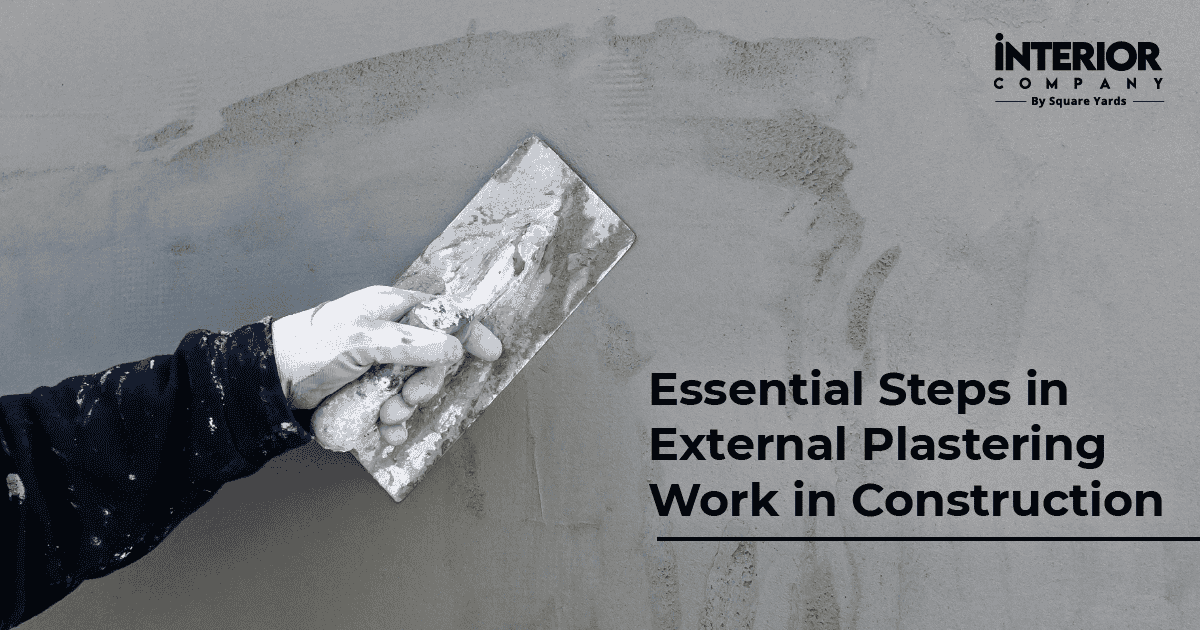In this blog, we will learn about the external plastering process that acts as a damp-proof course protecting the surface from atmospheric influences and creating a suitable finish for painting.
Purpose of Plastering
It is a crucial part of the process in engineering works and serves several purposes. It offers protection from environmental factors causing structural damage. The finishing coat of plaster can be tailored to create a variety of textures and colours, inducing a unique look. Plastering provides insulation for the building to regulate the temperature and improves overall energy efficiency. The multi-purpose plaster ensures the longevity and functionality of a building.
Also Read: Factors that Affect the Construction Cost
Types of Finishes Civil Plastering Work
Types of finishing treatments adopted for external building plastering work are given below:
- Smooth Cast Finish
- Scraped Finish
- Textured Finish
- Pebble Finish
- Rough Cast Finish
- Machine-Applied Finish
Procedure for Plastering Work
External plastering is a complex process that involves a few steps, all tailored to the scope of the project. Generally, this includes:- preparation of the surface, applying the first coat of plaster, allowing it to dry, finishing the work and curing the finished product.
Step 1- Preparation of Surface
- Start with preparing the wall to be plastered by ensuring that all mortar joints are rough and clean, free from dust, oil, grease, or any other biological growth to provide good bonding.
- Fill any holes or cavities in advance with the appropriate material. Wet the surface for at least 6 hours before applying the plaster so that it doesn’t absorb any moisture content.
- If the surface of the wall is old or smooth, then rake out the joints to a depth of 12mm for better bonding. Keep the thickness of the single coat not more than 12 mm to obtain uniformity.
Step 2- Groundwork for the Plaster Work
- To ensure a consistent thickness layer of plaster on a wall, start by affixing 15x15mm patches of plaster at intervals of two metres, both horizontally and vertically.
- Take the help of a plumb-bob to check for accuracy that the dots are vertically aligned.
- Afterwards, use the spots as a guide to form vertical strips (screeds) to sustain the dense profile.
Step 3- Base Coat
- Before applying the first coat of plaster, measure the thickness of the plaster, which is generally 12 mm for brick masonry and between 9 to 15 mm for concrete masonry.
- Take the cement-to-sand ratio for the first coat between 1:3 to 1:6. Start smearing the plaster between the screeds on the wall surface with the help of the trowel and then level the surface using wooden floats and edges, ensuring it gives a uniform surface.
- Then roughen the surface in its wet stage with a scratching tool before applying the second coat of plaster to form optimal bonding.
Step 4- Finishing Coat
- Let the first layer be dampened evenly before applying the finishing coat of plaster.
- In this coat, the ratio of cement to sand should range from 1:4 to 1:6, and the thickness varies between 2-3mm.
- After applying the final coat with a wooden float, use a steel trowel or spray gun to give it the desired texture. It is best to work from top to bottom for a seamless look and impeccable finish.
Also Read: Types of Sand Used during the Construction
Step 5- Curing
- After finishing the plastering works, it must be regularly watered for a span of seven days to ensure high strength and durability.
- Utilise Gunny bags or other materials for external work to prevent drying.
- Failure to properly cure the plaster could lead to cracks and efflorescence.
How To Check Plastering Work Quality
- Prior to external plastering, the masonry surface must be adequately soaked to prevent moisture from the mortar. The mixing of mortar should adhere to the specified water-cement ratio to achieve the required consistency.
- The cement plaster should be used within an hour of preparation. Allow any electrical points installation, such as DB boxes, fan boxes, and junction boxes.
- Ensure beading or drip moulding is finished at chajjas, parapet walls, and sills to prevent rainwater from seeping into the home.
- If any bumps are detected, they must be promptly corrected to lend a smooth surface.
Benefits of Plastering
External plastering work in construction offers a plethora of advantages for both residential and commercial projects. Investing in high-quality plastering brings numerous benefits, such as protection from the elements against wind, rain, and sun. It strengthens durability, enhances aesthetics, and increases property value.
Moreover, the cement plaster provides an additional layer of protection in harsh weather conditions. Plus, it can be customised to match the existing style of the building, exemplifying the visual appeal whilst making it an attractive and cost-effective solution. Also, the multipurpose plaster boosts the home value and ensures a profitable return on your investment.
In A Nutshell
The method of plastering in civil engineering involves several steps, including surface preparation, groundwork, application of the double coats, and curing and finishing. Contact the professional experts at Interior Company that make sure the process is carried out with the utmost care and precision, providing durability, timeless look and aesthetic appeal.
